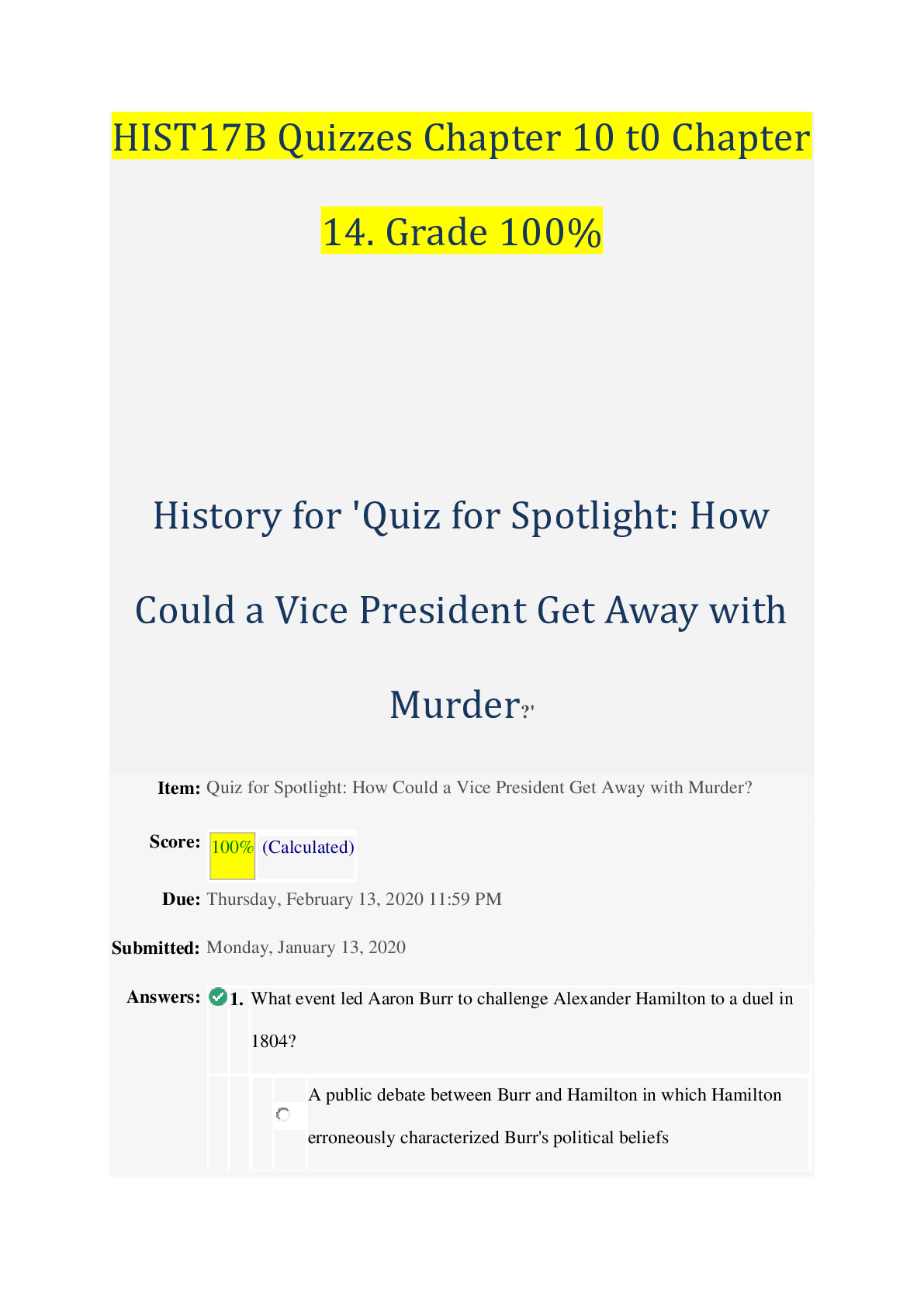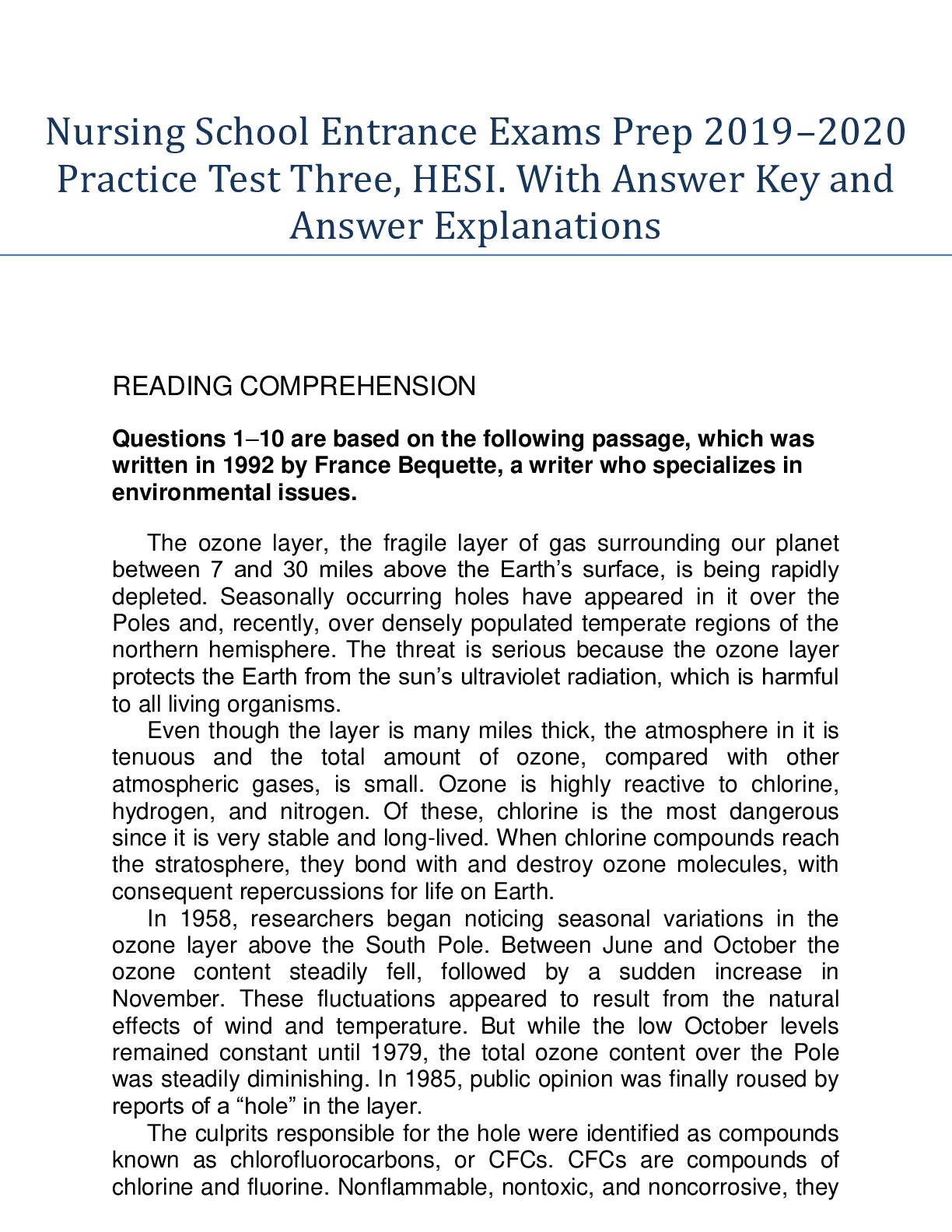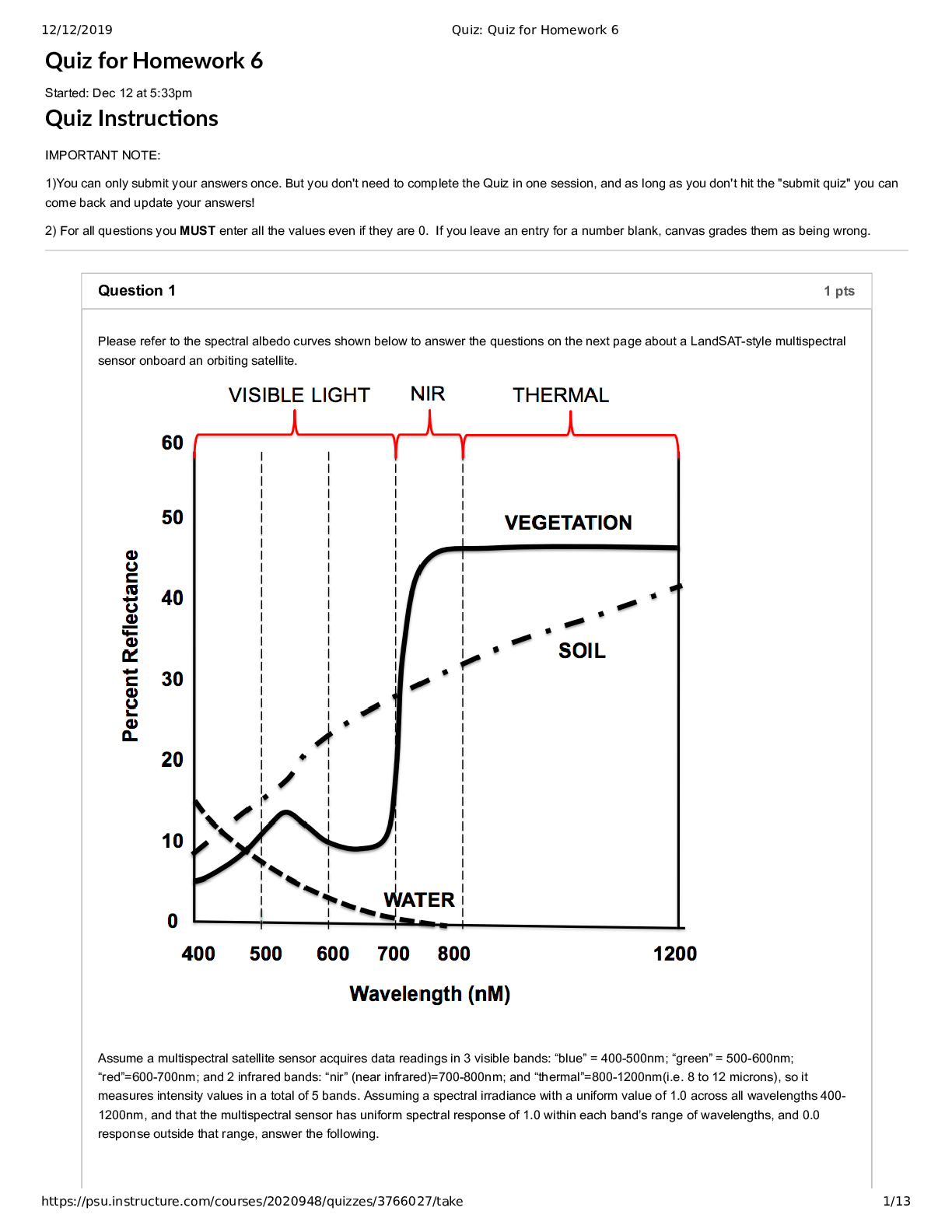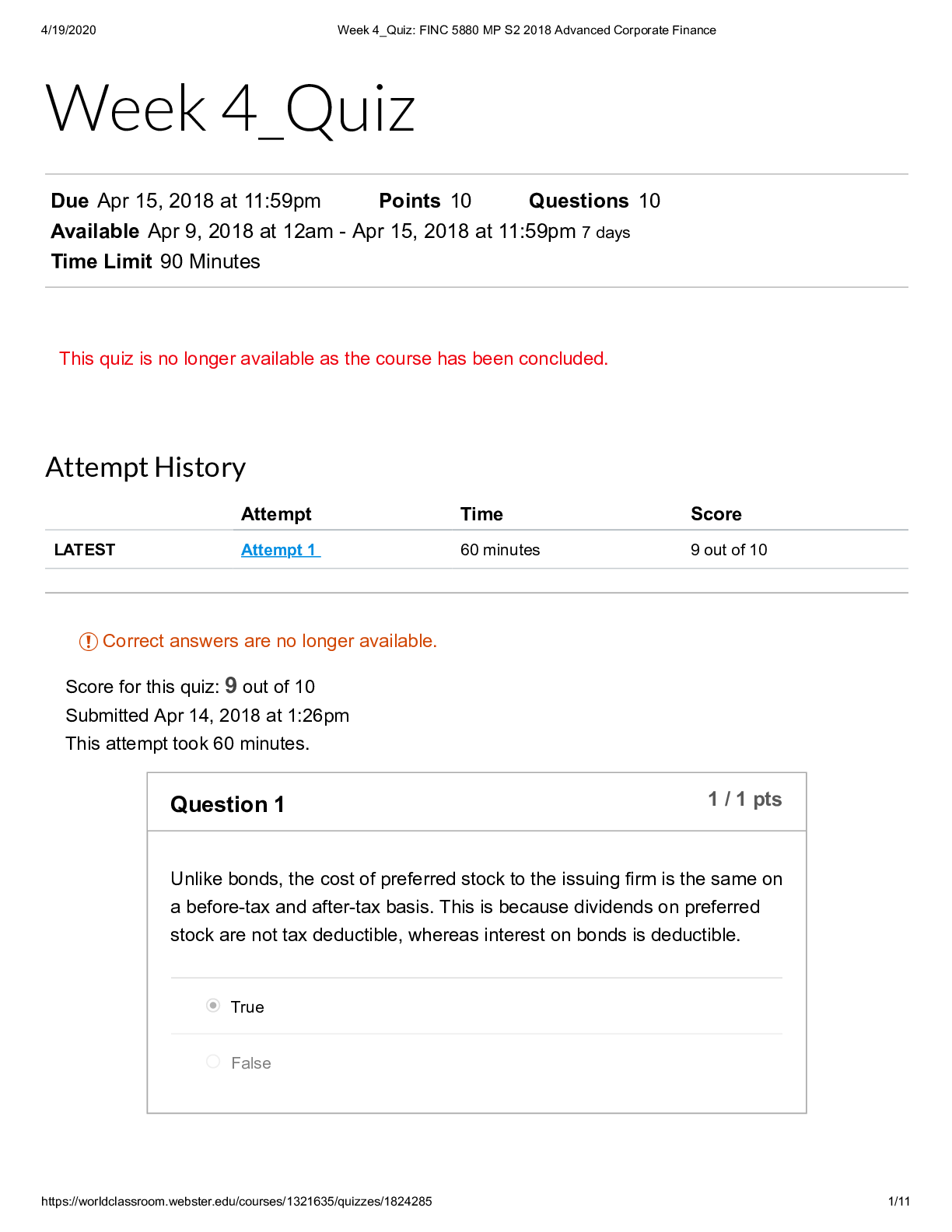History > QUESTIONS & ANSWERS > HIST 17B Quizzes Deanza College. QUIZ FOR ANALYSING HISTORICAL EVIDENCE: The Nation’s First Forma (All)
HIST 17B Quizzes Deanza College. QUIZ FOR ANALYSING HISTORICAL EVIDENCE: The Nation’s First Formal Declaration of War_The Nation‘s First Formal Declaration of War, Mill Girls Stand Up to Factory Owners, 1834', The Gold Rush, Defending Slavery, Southerners Debate Secession. Score 100%.
Document Content and Description Below
History for 'Quiz for Spotlight: How Could a Vice President Get Away with Murder?' Item: Quiz for Spotlight: How Could a Vice President Get Away with Murder? Score: 100% (Calculated) Due: Thursd... ay, February 13, 2020 11:59 PM Submitted: Monday, January 13, 2020 Answers: 1. What event led Aaron Burr to challenge Alexander Hamilton to a duel in 1804? A public debate between Burr and Hamilton in which Hamilton erroneously characterized Burr's political beliefs A tavern fight in New York City, during which Hamilton caused a life-threatening injury to Burr's brother The publication of a newspaper article in which Hamilton said he distrusted Burr as a political leader An election for governor of New York in which Hamilton defeated Burr with a sizeable majority Score: 1 of 1 2. How did Northerners and Southerners respond differently to the news of Aaron Burr and Alexander Hamilton's illegal duel in 1804? More northern states moved to criminalize dueling, while many southern states actually decriminalized dueling by the end of 1804. While Northerners and Southerners all mourned Hamilton's death, only Southerners attempted to get Burr removed from his position as Vice President. Northerners argued that Burr should be sentenced to murder, while Southerners argued for the lesser charge of issuing a challenge to duel. Northerners were angry and reaffirmed the criminalization of dueling, while Southerners felt that dueling was an acceptable practice. The response to the duel, and to the legality of dueling in general, was sharply divided along sectional lines. Dueling had recently been criminalized in many northern states, and in the years that followed Hamilton and Burr's duel, dueling became extremely rare in the North. By contrast, Southerners continued to embrace dueling as an acceptable extralegal practice in cases of insults to honor. There is no evidence in this essay that any southern states had criminalized dueling before 1804. Score: 1 of 1 3. On what grounds did the senate Republicans argue that Aaron Burr's indictment for murder should be dropped by the state of New Jersey? Dueling deaths were more civilized than common murders. The President and Vice President were immune from criminal charges. Aaron Burr had fired his gun at Alexander Hamilton in self-defense. The federal government, not New Jersey, had jurisdiction in such cases. Score: 1 of 1 4. On what grounds were duels fought in late eighteenth and early nineteenth century, as illustrated by the duel between Aaron Burr and Alexander Hamilton? As part of a battle during times of war To determine who would get a woman's hand in marriage In retribution for acts of physical violence To redress insults to a gentleman's honor Score: 1 of 1 5. What does the story of Aaron Burr and Alexander Hamilton's duel suggest about early American masculine culture? Holding political office was considered the pinnacle of masculine achievements, and men were willing to do anything to maintain their positions. One source of sectional tension already evident in the early Republic was that the North and the South had different notions of masculinity. A man's honor was one of his most highly prized qualities, and insults to honor were offenses worthy of extreme acts of retribution. Masculine culture in the early nineteenth century was characterized by an affinity for shooting, hunting, and other forms of outdoor recreation. Score: 1 of 1 History for 'Quiz for Analyzing Historical Evidence: The Nation’s First Formal Declaration of War' Item: Quiz for Analyzing Historical Evidence: The Nation’s First Formal Declaration of War Score: 100% (Calculated) Due: Thursday, February 13, 2020 11:59 PM Submitted: Monday, January 13, 2020 6:20 PM Answers: 1. How did the Federalists think that the majority of the American people felt about war? The majority opposed the war. The majority were ambivalent about a war. The people were bloodthirsty and wanted to go to war. The American people supported the war for selfish reasons and could not be trusted. Score: 1 of 1 2. Which of the following did Federalists at the Boston town meeting propose? Sending arms to France Sending more diplomats to Great Britain Remaining neutral Electing new members of Congress Score: 1 of 1 3. According to Congress, how had the British been violating the rights of American citizens? They refused to pay American merchants for their goods. They impressed American citizens to work on British ships. They refused to allow Americans to travel to and from Great Britain. They stole land from Americans on the frontier. Score: 1 of 1 4. How did Native Americans factor into arguments in favor of war with Britain? Congress argued that Native Americans would be strong American allies. Congress claimed that Great Britain was using Native Americans as spies. Congress claimed Great Britain was supplying arms to Native Americans. Congress hoped that most of the tribes would remain neutral. Score: 1 of 1 5. What did Congress fear would happen if the United States did not go to war with Britain? The United States would face degradation and a loss of sovereignty. Many Americans would decide to immigrate to other countries. France would no longer support the United States. The United States would forfeit its claims to its territories. Score: 1 of 1 Item: Map Quiz for Chapter 10 Score: 100% (Calculated) Due: Thursday, February 13, 2020 11:59 PM Submitted: Monday, January 13, 2020 6:21 PM Answers: 1. The division between slave states and free states was determined by the Missouri Compromise Line. Oregon Country Border. Adams-Onis Treaty Line. Florida Annex Line. Score: 1 of 1 2. The unorganized territory on the map was designated as what type of territory? Native American territory Free territory Mixed territory Slave territory Score: 1 of 1 3. Which state was a slave state during the 1820s? Virginia Maine Connecticut Pennsylvania Score: 1 of 1 History for 'Quiz for Analyzing Historical Evidence: Mill Girls Stand Up to Factory Owners, 1834' Item: Quiz for Analyzing Historical Evidence: Mill Girls Stand Up to Factory Owners, 1834 Score: 100% (Calculated) Due: Thursday, February 13, 2020 11:59 PM Submitted: Wednesday, February 12, 2020 1:49 PM Answers: 1. The Lowell Journal report of the strike portrayed most of the striking women as violent and threatening. foolish and misled. reluctant and coerced. evil and malicious. Score: 1 of 1 2. To describe their treatment by factory owners, the striking women used the analogy of colonialism. domestic service. prostitution. slavery. Score: 1 of 1 3. According to the strike leader quoted in Document 3, the “turn out” was principally about patriotism. money. politics. dignity. Score: 1 of 1 Sdd Item: Map Quiz for Chapter 11 Score: 100% (Calculated) Due: Thursday, February 13, 2020 11:59 PM Submitted: Wednesday, February 12, 2020 1:51 PM Answers: 1. Which Indian tribe was removed from the Florida Territory after land was ceded in 1832? Creek Seminole Chickasaw Cherokee Score: 1 of 1 2. The Cherokee Indians were moved to reservations further west by a route that passed through New Orleans, Louisiana. Vicksburg, Mississippi. Springfield, Missouri. Mobile, Alabama. . Score: 1 of 1 3. According to the map, which tribe's land was the last to be ceded to the United States? The Creek The Choctaw The Chickasaw The Cherokee Score: 1 of 1 History for 'Quiz for Spotlight: Who Scorned Temperance and Moral Reform?' Item: Quiz for Spotlight: Who Scorned Temperance and Moral Reform? Score: 100% (Calculated) Due: Thursday, February 13, 2020 11:59 PM Submitted: Wednesday, February 12, 2020 1:52 PM Answers: 1. According to this passage, what historical development led to a “boisterous subculture” among young men? Temperance movements Social stratification Industrialization Urbanization Score: 1 of 1 2. Which of the following is true about male subcultures in mid-nineteenth century America? The moralists of the age denounced them as lewd and wasteful. They arose and disappeared for reasons that historians do not know. The consumption of alcohol was the main component uniting these subcultures. There were varying subcultures for men of different classes and outlooks. Score: 1 of 1 3. What was the historical importance of the scandalous weekly newspapers written by young men between 1835 and 1845? They revealed the existence of a culture of vice activity in American cities during the mid-nineteenth century. They uncovered a countrywide association of young men who were opposed to the concept of marriage. They uncovered the ways in which moralists sought to curb drinking through grassroots movements. They revealed how the publishing activities of young men led to increased support for the temperance movement. Score: 1 of 1 History for 'Quiz for Spotlight: How Did the American Economy Compare to the Rest of the World?' Item: Quiz for Spotlight: How Did the American Economy Compare to the Rest of the World? Score: 100% (Calculated) Due: Thursday, February 13, 2020 11:59 PM Submitted: Tuesday, February 11, 2020 1:02 PM Answers: 1. How did American transportation change between the presidencies of Thomas Jefferson (which began in 1801) and Abraham Lincoln (1861)? Americans transitioned from primarily water-based travel to land-based travel. The majority of new roadways were built on a north–south orientation by the 1860s instead of an east–west orientation. U.S. roadways were comprised of bumpy dirt roads in the early 1800s and they were later built into smooth, paved roads by the 1860s. American travelers relied less on traveling by horse and more on traveling via a network of railroads by the 1860s. Score: 1 of 1 2. The reason that Great Britain, the United States, France, and Germany were far more prosperous than most of the rest of the world in the 1850s was because all four countries had industrialized. were in the Northern Hemisphere. had primarily urban populations. controlled immense coal resources. Score: 1 of 1 3. How did Great Britain's high wages make its industries more efficient, therefore helping to make Great Britain the world's most prosperous nation in the 1850s? High wages were used as an incentive to workers, who only received raises if they met their efficiency quotas. Highly paid British workers tended to work more efficiently than less-well-paid laborers in other countries. High wages incentivized companies to replace human workers with machines, which were more efficient. British workers used their high wages to purchase many goods and services, which spurred production. Score: 1 of 1 4. Although Britain and the United States had very similar sized populations in the 1850s, in what way were the demographics of the two countries significantly different? The number of workers in the service industry The number of people who owned their own home The percentage of impoverished people in the general population The percentage of the population that lived in towns and cities Score: 1 of 1 5. Although the United States had the second highest per capita production of goods and services in the 1850s, which of the following groups likely did not experience the benefits of that prosperity? Southern slave owners Gold miners in California Merchants in New York City Poor farm families Score: 1 of 1 Knjkn History for 'Map Quiz for Chapter 12' Item: Map Quiz for Chapter 12 Score: 33% (Calculated) Due: Thursday, February 13, 2020 11:59 PM Submitted: Tuesday, February 11, 2020 7:23 PM Answers: 1. Those who sought to settle in California would have first reached Sutter's Fort. Santa Fe. Oregon City. Salt Lake City. Score: 1 of 1 2. Settlers who were escaping religious persecution during the mid-1800s would have traveled along which trail? The Oregon Trail The Santa Fe Trail The Mormon Trail The California Trail Score: 1 of 1 3. Which factors likely made the Oregon Trail a long, difficult, and sometimes deadly trek for Americans? Threats from Spanish warriors and passing through the Rocky Mountains Crossing the Mississippi River and the hot, dry climate Threats from Native Americans in the Republic of Texas territory and crossing the Colorado River Passing through the Rocky Mountains and the harsh, cold winters Score: 1 of 1 History for 'Quiz for Analyzing Historical Evidence: The Gold Rush' Item: Quiz for Analyzing Historical Evidence: The Gold Rush Score: 100% (Calculated) Due: Thursday, February 13, 2020 11:59 PM Submitted: Tuesday, February 11, 2020 7:34 PM Answers: 1. How did Americans living on the East Coast get to California during the Gold Rush if they did not want to, or could not afford to, travel by boat? On foot or in a covered wagon across the continent On a train from Chicago to San Francisco Through Canada, riding on horseback Through Oklahoma, led by a Native American guide Score: 1 of 1 2. According to James Marshall's account of finding gold in 1848, which of the following is probably the reason Marshall urged his men to stay quiet about his discovery? Marshall worried that the two pieces of gold he found in the river were not actually gold but iron pyrite, and wanted to have the gold certified first. Since Marshall was a very private and withdrawn man, he worried that news of a gold discovery would bring thousands of unwelcome people to the area. Marshall was prejudiced against the Mormon faith, and he wanted to keep the gold a secret from the Mormon soldiers nearby so they would not become rich. The men needed to finish their job (building the sawmill) before they could go look for gold, and Marshall worried others would get to it first if word got out. Score: 1 of 1 3. What does Sarah Royce's story suggest about the potential difficulties of traveling to California by covered wagon during the Gold Rush? Travelers might become the victims of theft if they encountered a group of desperate migrants who had run out of supplies. A wagon party could encounter chaotic and unruly Army troops along the way, and might be harassed by the soldiers. The cattle that pulled the wagons could die unexpectedly, forcing a family to abandon many of its supplies. The dead bodies of cattle might attract aggressive condors or vultures, which might try to attack living cattle, too. Score: 1 of 1 4. Daniel B. Woods argued that gold mining in the California Gold Rush was uniquely frustrating because, compared to other kinds of work, gold mining was extremely uncertain. demeaning. unfulfilling. tedious. Score: 1 of 1 5. These documents support which of the following historical arguments? The poor diets of aspiring Gold Rush miners, both during their journey and in the gold fields, led to increased mortality rates in the United States in the 1850s. American women found the journey west for the Gold Rush especially difficult because they were expected to care for their families while also searching for gold. The wealth the Gold Rush offered to Americans was particularly attractive because John Marshall's discovery occurred during the recession of 1847–1848. Both the journey to the Gold Rush in California and the work to find the gold were extremely difficult. Score: 1 of 1 Hdh History for 'Quiz for Analyzing Historical Evidence: Defending Slavery' Item: Quiz for Analyzing Historical Evidence: Defending Slavery Score: 100% (Calculated) Due: Thursday, February 13, 2020 11:59 PM Submitted: Monday, February 10, 2020 3:50 PM Answers: 1. Which concept did William Harper use in his justification for slavery? Manifest Destiny Christianity States' rights The Monroe Doctrine Score: 1 of 1 2. John C. Calhoun claimed that the conditions of slavery in the U.S. South were preferable to the “savage” life of American Indians. life in the poor houses of Europe. labor in the factories of the North. slavery during Jesus' lifetime. Score: 1 of 1 3. According to Thornton Stringfellow, why should slaveowners treat their slaves well? Fair treatment would prevent slaves from rebelling against their masters. Jesus commanded that people treat others as they wish to be treated. Just ownership of slaves would undermine the abolitionist argument. Masters would be judged by God for the treatment of their slaves. Score: 1 of 1 History for 'Map Quiz for Chapter 13' Item: Map Quiz for Chapter 13 Score: 100% (Calculated) Due: Thursday, February 13, 2020 11:59 PM Submitted: Monday, February 10, 2020 3:51 PM Answers: 1. Which state produced rice during the mid-1800s? Arkansas Florida Virginia South Carolina Score: 1 of 1 2. A slave who labored in Georgia during the mid-1800s would have likely worked in cornfields. picking cotton. on a tobacco farm. in sugarcane fields. Score: 1 of 1 3. Which statement might explain the reason lumber was produced in areas where cotton was also produced during the mid-1800s? As cotton agriculture expanded, slaves had to clear forests to make way for new plantations. The trees in the South were hearty and the type of wood from them was in high demand. During the off-season on cotton plantations, slaves had to cut trees and make planks. The South had a booming lumber economy prior to the expansion of cotton agriculture. Score: 1 of 1 History for 'Quiz for Spotlight: Cotton’s Global Empire' Item: Quiz for Spotlight: Cotton’s Global Empire Score: 100% (Calculated) Due: Thursday, February 13, 2020 11:59 PM Submitted: Monday, February 10, 2020 3:53 PM Answers: 1. What technological innovation(s) allowed America to rapidly increase its cotton production and become the prime cotton supplier for several European countries? Faster ships to transport the cotton abroad More efficient machines to spin the cotton into yarn Modern city sewer systems to allow for a sufficient factory workforce A new machine to clean raw cotton Score: 1 of 1 2. How did cotton change the workforce in Great Britain? Cotton manufacturing drew many new workers from the British countryside. Workers now had more time off, and new leisure activities emerged. Great Britain imported many workers from its colonies abroad. African slavery was reinstituted in Great Britain. Score: 1 of 1 3. What impact did the growth of cotton production have on the workforce in the United States? It forced the government to become more involved in regulating the workplace environment. It caused the westward expansion of plantation slavery. It caused wage laborers to move from northern cities to the southern cotton-growing regions. It created a big demand for more immigrants to join the workforce. Score: 1 of 1 4. Why were European countries so dependent on the United States for cotton imports? European cotton production could not keep up with demand. American technology was better for growing cotton. American cotton was cheaper than European cotton. The European climate was not suitable for growing cotton. Score: 1 of 1 5. According to observers, what were the conditions for wage laborers in industrial cities such as Manchester and Liverpool? The new housing complexes for workers were very impressive and modern. Workers had more disposable income than they were used to having. Child workers were allowed to work shorter, easier hours. Working and living conditions were terrible. Score: 1 of 1 History for 'Map Quiz for Chapter 14' Item: Map Quiz for Chapter 14 Score: 100% (Calculated) Due: Thursday, February 13, 2020 11:59 PM Submitted: Monday, February 10, 2020 6:15 PM Answers: 1. According to the map, how many states and territories allowed slavery in 1854? Seventeen Thirteen Fifteen Nineteen Score: 1 of 1 2. The issue of slavery would be left up to popular sovereignty in which state or territory? Texas Minnesota Territory California Nebraska Territory Score: 1 of 1 3. The Compromise of 1850 allowed Native Americans to decide which state or territory they would like to establish reservations in. the Nebraska and Kansas territories to accept slavery through popular sovereignty. voters to decide on the issue of slavery in the Utah and New Mexico territories. California and Oregon to enter the Union as slave states. Score: 1 of 1 History for 'Quiz for Spotlight: ‘A Purse of Her Own’: Petitioning for the Right to Own Property' Item: Quiz for Spotlight: ‘A Purse of Her Own’: Petitioning for the Right to Own Property Score: 100% (Calculated) Due: Thursday, February 13, 2020 11:59 PM Submitted: Monday, February 10, 2020 6:16 PM Answers: 1. Under the laws of coverture, a married woman in antebellum America did not have the right to control which church her family attended. which man she married. how many children she had. the money she earned while married. Score: 1 of 1 2. What motivated many traditionalists to change their minds about women and property in the late 1830s, and push state legislatures to change the laws to give married women rights over the property they brought into their marriages? A cholera epidemic that killed thousands of married men Activism by early feminists like Susan B. Anthony The financial panics of the late 1830s A more open-minded perspective about women's rights Score: 1 of 1 3. Why did Ernestine Rose argue that the 1848 New York state law, which gave married women control over the property they brought into their marriages, was insufficient? Rose argued that married women's property laws would be ineffective so long as women lacked the right to vote. The law only applied to native-born married women, and Rose argued it should apply to immigrant women as well. The law did not give married women control over the money they earned while married, reserving that power for their husbands. Rose feared that the law would be interpreted to apply only to physical objects, like jewelry, and not currency, like gold or bank notes. Score: 1 of 1 4. Why were Ernestine Rose and Susan B. Anthony particularly worried about poor wives? Many poor women were forced by their circumstances to marry men they did not love, so they were more vulnerable to having bad husbands who refused to care and provide for them. Compared to middle and upper class women, poor wives were less likely to bring an inheritance into their marriages, so the new state laws about inherited property did not help them. Because married women were financially dependent on their husbands, poor women often found themselves trapped in marriages with men who could not support their children. Although all women lacked the right to vote, poor wives were less likely to have husbands with political power, so their needs were more likely to be overlooked or neglected. Score: 1 of 1 5. What might Ernestine Rose have argued is the connection between women's economic rights and women's equality? Women with an income were more likely to become involved in activism on behalf of women's equality than women who did not work. Rose argued that access to divorce was crucial to women's equality, and working women were able to divorce more readily than women without incomes. Women could not be independent, and thus equal to men, as long as they had to depend on their husbands for their economic livelihood. As long as married women were their dependents, American men would never vote for legislation that furthered women's rights. Score: 1 of 1 Oo History for 'Quiz for Analyzing Historical Evidence: Southerners Debate Secession' Item: Quiz for Analyzing Historical Evidence: Southerners Debate Secession Score: 75% (Calculated) Due: Thursday, February 13, 2020 11:59 PM Submitted: Monday, February 10, 2020 6:17 PM Answers: 1. According to William L. Harris, the United States was founded upon the idea of white supremacy. the principle of states' rights. the Constitution's checks and balances. the institution of slavery. Score: 1 of 1 2. To stop Lincoln and the abolitionists, Alexander Stephens advised trusting in the South's advantages in military leadership. the unpopularity of abolition among most people. the constitutional checks on the president. the North's fear of causing a civil war. Score: 1 of 1 3. What aspect of the 1860 election influenced South Carolina's decision to secede? Divisions among northern and southern Democrats, which made the party powerless in Congress Lincoln's campaign promised to end slavery, which threatened the Southern way of life Lincoln's popularity in the North, which divided the nation along sectional lines The South's united vote against Lincoln, which suggested broader support for secession Score: 1 of 1 4. These documents demonstrate that pro- and anti-secessionists in the South were primarily divided over the South's chances of defeating the North. loyalty to their state or the Union. what Lincoln would do once in office. the constitutionality of secession. Score: 1 of 1 [Show More]
Last updated: 9 months ago
Preview 1 out of 46 pages

Reviews( 1 )

by bigbot69 · 3 years ago
Document information
Connected school, study & course
About the document
Uploaded On
Feb 14, 2020
Number of pages
46
Written in
Additional information
This document has been written for:
Uploaded
Feb 14, 2020
Downloads
3
Views
182

















.png)







.png)


.png)


.png)



